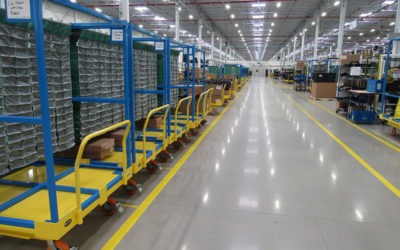So, you’re interested in pursuing lean manufacturing. Maybe some of your competitors have implemented lean strategies with success, or maybe you know it’s your only option to efficiently integrate that new product line into your facility. It’s clear that lean manufacturing has its benefits, but how, exactly, can lean manufacturing improve your bottom line? Let’s take a look:
What is Lean Manufacturing?
To really understand the benefits of lean, you first understand what we mean when we say lean manufacturing. Check out this blog: What is Lean Manufacturing? for a bit of context. If you’re already familiar with basic lean methodology, we’ll just leave you with this short definition:
Lean manufacturing is a production system that focuses on eliminating waste, without sacrificing product quality or productivity.
With that in mind, here are a few ways that implementing lean manufacturing can help improve your bottom line:
Decrease Unnecessary Storage Costs
One goal of lean manufacturing is to eliminate waste, in all of its forms. That includes excess products and parts. When your company is only stocking the product you physically need (and your customers need), you free up a great deal of space and resources. This eliminates costs associated with storing that product and opens up additional space in your facility that can be used for more profitable purposes: increased production or a more efficient configuration that allows for fewer production defects.
Reduce Overhead Expenses
When you minimize the amount of product you have on-site, you reduce your company’s overhead. The goal of lean manufacturing is to get your facility to the point where you’re only purchasing parts for products that have been ordered. In a perfect world, that would translate to virtually no overhead from parts, but at the very least, minimizing the parts you have in stock will reduce your upfront expenses, making your company more profitable on the whole.
Minimize Overproduction Waste
A classic failing of the American batch manufacturing system is overproduction. A company puts out millions of pairs of shoes or manufactures a huge run of heavy-duty trucks, only to see consumer demand fall off well before much of the product has been sold. At this point, the manufacturer must wholesale much of the finished product as well as the remaining parts that had yet to be put into the assembly.
Lean manufacturing minimizes the risk of overproduction because you’re allowing consumers to pull your orders through your facility. Each product you assemble is going to a specific consumer, which means you don’t have to worry about wasting money or devaluing your brand name by overproducing a lemon or a flash-in-the-pan consumer trend.
Reduce Waste Due to Production Defects
One often overlooked benefit of lean manufacturing facilities is the ability to zero in on product quality. When you assemble products based on consumer demand, your staff will have more time to oversee production and ensure there are no product defects.
Before lean manufacturing, employees focused on a batch production mentality — getting as many units put together in as little time as possible. This mentality tends to devalue quality and leads to a predictable percentage of production defects, a waste of material and a drain on your resources.
With lean manufacturing, the focus is not on putting out as much as possible, but rather just as much as is needed. This helps puts employee emphasis on production perfection; when products are assembled perfectly, the job is done. When they’re not, employees have to re-assemble, which is then seen as a waste of time and resources, rather than a necessary evil associated with the job.
More Agile Workforce
Lean manufacturing makes for an agile production facility and flexible workforce. When demand slows for one product, you can easily shift your workforce to products that have higher demand. Because your production has been streamlined, and parts are delivered to workstations only as needed, there’s no worry of waste due to lowered demand, and you can simply focus your workforce on the products that are driving demand. This makes for a profitable business strategy that is not at the mercy of consumer trends but rather rises to meet them.
Serves Customers While Reducing Cost of Business
When we discuss lean manufacturing, we start at the customer. Process change starts at the end and works forward to ensure that every process adds value to the end consumer. When done properly, lean manufacturing benefits the customer by offering a lower price for a quality product. Best, this price reduction does not come at the expense of your company. Your production is more efficient and cost-effective, which means you can offer products at an affordable price while still turning a decent profit because of the reduced cost of business that lean manufacturing has provided.
Interested to see how lean manufacturing could benefit your bottom line? Let Geolean USA know! We’d be happy to come out and walk your facility floor, letting you see through our eyes where our proven systems can minimize overhead and produce more efficiently and profitably.




